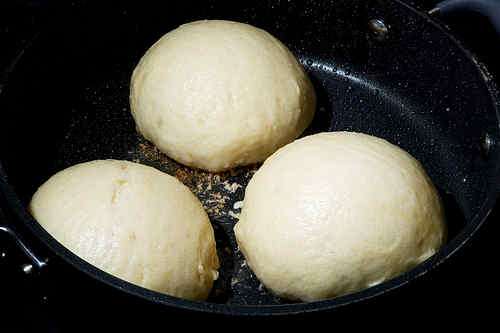Dampfnudeln
Sun, 01/27/2008 - 19:02 — Steffen
 Printer-friendly version
Printer-friendly version PDF version
PDF version
Dampfnudeln are not noodles as their German name might suggest. They are steamed dumplings.
In my childhood it was always a special day when my Grandmother made Dampfnudeln. Back then I didn't like the potato soup or the wine sauce that was usually served together with them, but I loved the dumplings!
Dampfnudeln go well with a flavorful potato soup or a stew, but you can also serve them with wine mousse or vanilla sauce.
This recipe is from my grandmother's collection.
Ingredients
- 1lb 2oz / 500g flour
- 1 egg
- 1 package active dry yeast
- 3 oz / 90g butter, melted
- 2 oz / 60g sugar
- 1/8 tsp salt
- ca. ½ - ¾ cup / 120 - 180ml milk
- vegetable oil, salt, water
Preparation
- Dissolve yeast in a bit of milk. Sift flour into mixing bowl. Make a depression in the center. Pour in yeast, add a pinch of sugar and stir lightly. Let ferment until bubbly.
- Add egg, sugar, salt and melted butter. Initially add 1 cup / 120ml of milk. Knead with dough hook, adding milk as necessary to obtain a smooth but not too soft dough.
- Form a ball, coat with vegetable oil, cover and in a warm place let rise until volume has doubled.
- Flatten dough and divide into 8 equal pieces. Shape each piece into a ball. Put on baking paper, cover with a damp kitchen towel and let rise in a warm place for another 20 minutes.
- In a heavy non-stick pan (see notes) bring 1 cup / 240ml of water to a boil. Add 1 tsp salt and 4 tbsp olive oil. Put in 3 - 4 dough balls and cover immediately. Do now crowd the pan, the dumplings will expand quite a bit.
- Cook over low-medium heat until all the water has evaporated and nice brown crust has formed on the bottom of the dumplings (ca. 15 - 20 minutes). The dumplings will start to make crackling noises when they are close to done. Do not open the lid until the dumplings are fully cooked, otherwise they will deflate!
- When removing the lid, avoid to drip water on the dumplings.
- Repeat until all the dumplings are done.
Notes
- Dampfnudeln can be served warm or cold. I think they taste much better fresh out of the pan.
- Traditionally, dumplings are steamed in a heavy cast iron dutch oven. I find it much simpler to use a high-quality heavy (anodized aluminum) non-stick pan with a tight-fitting lid. A glass lid is ideal.
Preparation time: 2 - 3 hours.
Yields 8 Dampfnudeln














Comments
Dampfnudeln!
Yum! Steffen, where is your hometown? I ate these when I was an exchange student in Rheinland-Pfalz, but none of my Schwiegerleute in North Rhine-Westphalia have ever mentioned them.
Denise, I'm from
Denise,
I'm from Rheinland-Pfalz in the Frankenthal area.
Cheers,
Steffen
YAY!
My husband and I were stationed in Wurzburg, and used to get these down in the marktplatz...I've been searching for a recipe for the last few years! These look very similar, hopefully they taste similar, too!
Danke!
Teresa
Die Tolle Dampfnudeln
We watched our Mom, also from Rheinland-Pfalz, make these many times. We would always fight to get to the table and grab the first one that had the thickest crust on the bottom. She always brushed the bottom of the heavy pot with a piece of bacon fat and salted liberally. The bottom crunchy saltiness was great next to the soft melt in your mouth doughiness of the bun. The trick was always to pick up the lid real fast without getting any moisture drops on the dampfnudeln, it would make them collapse. One of my fav. meals with fresh homemade soup.
I first tried these in South
I first tried these in South Africa! My husband's aunt makes them and was kind enough to give me her recipe. She uses sunflower oil and sugar in the water along with salt. Makes for a nice carmelized, salty crust on the bottom (my favorite part!). Our secret to know when they are done is by the smell!
German Kaesekuchen
Steffen, can you geive me more detailed direction on how to process the cottege cheese and use it in place of Quark. My first attempt was a flop. The cake looked great while baking and the tope was firm with a little bounce, but once it was cooled, and the form removed. I realized that the cheese did not fully solidify and there was a watery ooozz on the counter. Is there any help you can offer me? Thanks, Reinhard
Kaesekuchen
Reinhard,
Sorry to hear that your cheesecake didn't work out. I'm lucky enough to usually get real quark at one of our local markets, but I've successfully used cottage cheese as a substitute. From your description, I suspect that you might have added too much liquid. I really just used enough so that it would blend (about 9 parts of cottage cheese and 1 part of milk, but that's just an estimate since I didn't measure this exactly).
I'll try next time and measure the quantities.
Steffen
Viel Danke!
Hi, I was looking every where for this recipe. It was one of my favorite dessert when I lived in Germany. Thank you so much! Awesome!
http://veroitaliano.blogspot.com/